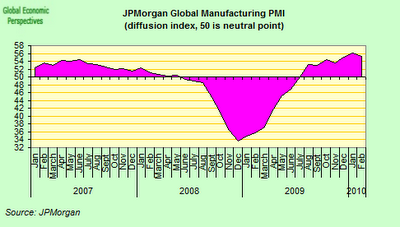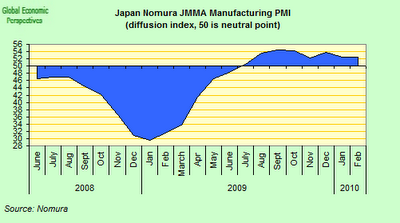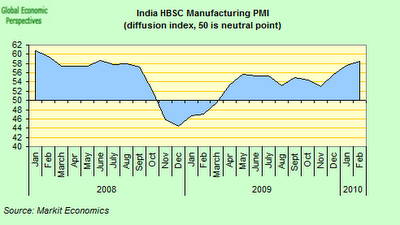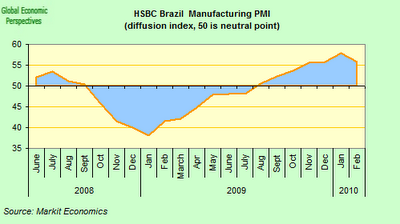The "Three Speed" global manufacturing recovery continues in February
This is a post by Edward Hugh, who also blogs at Global Economy Matters.
Global manufacturing activity continued to expand in February, albeit at a slightly weaker pace than in January. At 55.2, down slightly from 56.1 in January, the JPMorgan Global Manufacturing PMI posted its second highest reading in almost four years. The average reading so far in Q1 2010 (55.7) is above that for Q4 of last year (54.2). The headline Manufacturing PMI has now remained above the no-change mark of 50.0 for eight successive months.
The PMI is a composite (diffusion) index in which current output – which stood at 57.4 in February, down from 60.2 in January – is only one component. Despite this slight slowdown – it was the lowest reading in three months – production increased for the ninth month running.
Basically I think it is possible to divide the respective economies into three broad groups.
In the first place there are a bunch of emerging economies (largely in Asia, but also Brazil, and now increasingly South Africa) where the recovery continues apace, and the only real doubt is about China, and what happens to manufacturing momentum as inflation takes hold and the central bank tightens liquidity provision.
Then come the main group of developed economies, where recovery continues, but at a fairly muted pace. Sweden stands out for the expansion in its industrial sector, as does France, where despite the fact manufacturing only expands at a medium pace it is supported by strong domestic demand. The industrial recoveries in the US and Germany seem more fragile, the former for uncertainties about what will actually happen as the stimulus effect weakens, and the later due to the heavy dependency on exports.
Finally we have the stragglers – characterised by Greece and Spain – where the manufacturing sectors struggle to find oxygen. Also manufacturing activity in Ireland, Russia and Italy remains fragile.
Central Europe had a positive month in February, though at this point it is not clear to what extent this is dependent on the uptick in Germany, and thus what will happen if German activity weakens.
The Japanese Enigma
Japan however remains an enigma, since the impression given by the December data of slowing continues to be reinforced by the February manufacturing PMI. The reading at 52.5 was identical with January one, but both were down by 1.3 points compared to December.
Export sales were up sharply in February, but the level of new business taken by Japanese manufacturers rose at only a marginal rate – the slowest in the current eight-month period of expansion. Respondents widely attributed slower new business growth to weak domestic consumption. So Japan has a dual economy, and the domestic one still isn’t getting traction from the export sector. Japan’s exports are mainly supported at this point by demand from Asia, especially China, and it remains to be seen what will happen when China eventually starts to slow.
The New Export Orders Index rose rapidly – by 3.7 points to 55.2 – suggesting that export growth gained significant momentum on the month. But with the yen trading at around 90 to the USD (compared with the break even point for export companies of 92.9 yen per dollar reported in the full year 2009 survey) this may well gradually have a negative impact on exports and thus it is quite possible that growth in exports will slow in the near future, with problematic consequences for an export dependent Japanese economy.
The Emerging World Continues It’s Strong Performance
India now seems to be leading the charge, and the seasonally adjusted PMI climbed for the third month running to 58.5 – up from 57.6 in January – suggesting a further significant improvement in the operating conditions faced by Indian manufacturers.Behind the latest rise in the headline index were faster increases in new orders, output and employment.
Brazil’s manufacturing sector also expanded at a marked pace in February, although growth cooled slightly from January’s series-record performance. Both output and new orders grew strongly, while job creation accelerated again. On the inflation from survey respondents reported rising price pressures, as higher demand for raw materials, capacity constraints at suppliers and unfavourable exchange rates pushed up input prices.
The headline seasonally adjusted Brazil Manufacturing PMI in fact slipped from January’s survey high of 57.8 to 55.8 in February. Despite the slightly weaker expansion pace the latest reading still indicates a marked improvement in operating conditions during the month. Total incoming new business expanded for the seventh month running in February, although the latest increase was the weakest since last October. Both domestic and foreign sales rose on the month, however survey responses showed that the former remained the primary driver of overall new order growth. Anecdotal evidence suggested that a combination of better global economic conditions and successful promotional activities underpinned gains in new work.




Comments are closed.